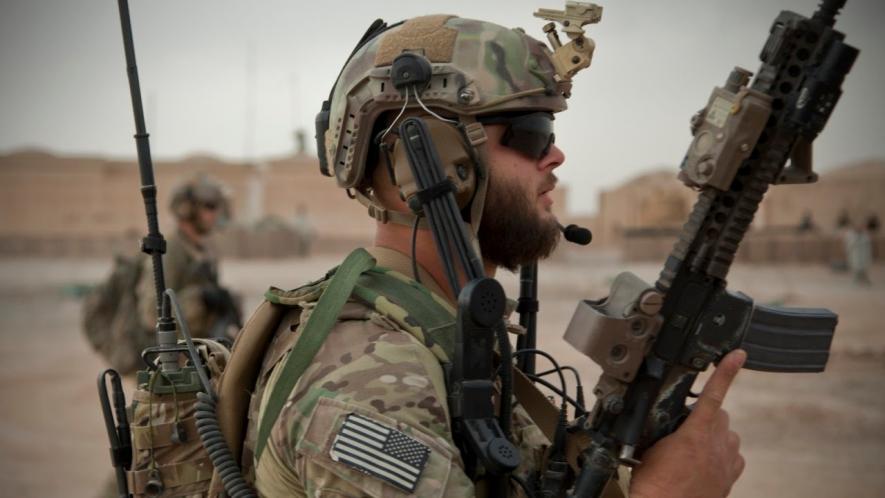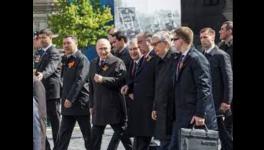Afghanistan: Suffering the Cost of 'Operation Enduring Freedom'

Death and killings have become everyday news in Afghanistan, only numbers differ. More than 16 years after United States-led invasion of Afghanistan- Operation Enduring Freedom (OEF), Afghanistan is still struggling to find a space for peace and stability.
OEF, like many other ridiculous military operations (Ops Freedom Deal, Ops Rainbow, Ops Olive Branch), far from achieving ‘the promise of securing freedom, did the very opposite’. Ironically, Operation Freedom's Sentinel is the new codename for the current US military operation (since 2015) in Afghanistan!
In past couple weeks, only Afghanistan witnessed four militant attacks, many of which were at the heart of its capital Kabul. This Monday, four militant attacked the Marshal Fahim Military Academy in Kabul killing 11 and wounding 16. On Saturday, more than 100 people were killed when an ambulance packed with explosives detonated at the checkpoint.
"I felt the earth shaking first for a few seconds then the explosion," 48-year-old Kamaludin, who witnessed the ambulance blast, said. "I was like 50 meters away. I fell to the ground ... (then) I saw the carnage. I saw a lot of blood, body parts."
A week before that, militant stormed the Kabul’s Intercontinental Hotel, killing at least 18 people, including 12 foreigners, during the 12-hour standoff with security forces. A day after the hotel attack, militants attacked the British aid organization Save the Children in the eastern Afghan city of Jalalabad killing at least four people and injuring dozens.
These are the details and causality numbers of some of the ‘hundreds of major and thousands of minor attacks’ the country had been suffering since the day US forces began bombing Afghanistan on October 7, 2001.
Around 16 years after the forces of Uncle Sam set foot on the Afghan soil to ‘bring freedom’, more than 70 percent of the districts in the country are still have active Taliban presence. According to a BBC estimate, around four percent of the country is under Taliban control. But US and NATO forces continue to assert that the Afghanistan government forces have an upper hand.
FRAGILE STATE AND ECONOMY
Kabul itself agrees to the fragility, in terms of logistics, of the government force in maintaining its ‘control’ in many parts of the country. Recently, Afghanistan’s Presidents Ashraf Ghani said the national army wouldn’t last longer than six months without US support, who contribute around 90 percent of Afghanistan’s defence budget.
Afghanistan’s economy is also in doldrums as the country is highly depended on foreign aid, mostly provided by the parties to the war. The government is facing challenges to finding sustainable sources of growth and controlling poverty, which is increasing. The withdrawal of a large number of foreign troops in 2011 had a deep impact on the country's economy that had been surviving on the massive war requirements of the foreign forces. Economic growth has gone down considerably from an average rate of 9 percent a year to 3-4 percent since the troops pulled out.
Robert Fisk, a Middle East correspondent, notes that the country has also become a battleground for NGOs and humanitarian organisations. “The NGOs arrived with millions to spend – all competing with each other and with the US military which offered even more millions in humanitarian aid in return for intelligence information.”
On the other hand, opium economy is booming- it has hit an all-time high. According to the data available, from 2016 to 2017, there had been an increase of 63 percent in the area where poppy is cultivated in Afghanistan, to 328,000 hectares (ha). The estimated total production of opium shot up by 87 percent to 9,000 metric tons (mt). And the drug trade continues to protract the war by fuelling warlords' coffers with the help of US forces. These warlords back the US forces in the military operation by providing intelligence support and even taking part in military operations. Many of them have a strong influence in the government and are responsible for many atrocities against the people.
THE PROTRACTED WAR, AGAIN GETS PROTRACTED
According to Lew Rockwell, chairman of the Ludwig von Mises Institute, the American forces has no business in Afghanistan but it loves war and could be there for another 17 years, killing hundreds of thousands of more people.
US President Donald Trump had recently announced that about sending in more troops and more planes and other weapons.
“A lot of Americans have a tough time understanding that they [Afghans] don’t like foreigners occupying them, installing a government they hate and running their lives, they don’t like it,” notes Rockwell.
“We need to have peace talks with the Taliban, I have no question that they would like to have peace talks with us that we could get out and let the Afghans handle their own lives in their own country. That is the only solution.”
Afghanistan has become one more weapon testing ground for the United States, which will help them to sell their ‘combat tested’ weapons across the globe. Apart from varieties of advanced drones that continues to kill people in the country, the US recently dropped- for the first time- GBU-43/B Massive Ordnance Air Blast Bomb (MOAB), nicknamed the mother of all bombs.
According to the US Air Force data, a total of 4,300 bombs were dropped on Afghanistan in 2017, more than a two-fold increase from 2016, when it dropped 1,337 bombs. According to the UN data made available last year, the US airstrikes has contributed to an increase in the civilian causality in 2017, with a 43% increase in casualties from the air.
“The main problem is that escalation, the fact that the Trump administration has no political, diplomatic strategy to end the war, just more violence. It’s been 16 years, the idea that more bombing can accomplish something fundamentally useful is preposterous,” Robert Naiman, policy director at Just Foreign Policy Group said.
As Trump continues to expand the military footprint in Afghanistan, more civilians become trapped in the fierce combat between the US forces that struggle to push back Taliban and Islamic State forces. Trump has clearly said that the US won’t engage in talks with Taliban and they are ‘going behind the terrorists’.
After the deadly blast in Kabul, the US president said that “We’re going to finish what we have to finish, what nobody else has been able to finish, we’re going to be able to do it.”
Trump administrations’ new Afghanistan is already on the roll with tUS sending more troops to the country. The Taliban also seems to have stepped up their offensive. And Islamic State forces, destroyed in other parts of the Middle East are also launching desperate attacks.
“If the Americans stay, I think the stalemate will continue,” asserts Mark Almond, director of the Crisis Research Institute in the UK.
“Because even if President Trump sends in more troops, he has already sent enough to actually swamp the opposition and to control the whole country.”
Overall, civilians continue to face the wrath of the war. As Andre Vltchek, an investigative journalist puts it-Afghanistan is now facing mortal danger. It has to survive, but it is not clear how it could manage.
Get the latest reports & analysis with people's perspective on Protests, movements & deep analytical videos, discussions of the current affairs in your Telegram app. Subscribe to NewsClick's Telegram channel & get Real-Time updates on stories, as they get published on our website.
























